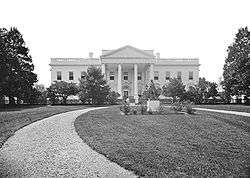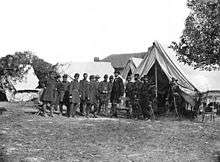William Henry Johnson (valet)
William Henry Johnson (March 4, 1833 – January 28, 1864) was a free African American and the personal valet of Abraham Lincoln. Having first worked for Lincoln in Springfield, Illinois, Johnson accompanied the President-Elect to Washington, D.C. for his first inauguration (1861).[1] He was the only person from Lincoln's Illinois entourage to travel all the way to Washington with Lincoln to elude potential assassins of the Baltimore Plot.

Once there, he was employed in various jobs, part-time as President's valet and barber, and as a messenger for the Treasury Department at $600 (equivalent to US$17,073 in 2019) per year.[2] He traveled with Lincoln in November 1863 to Gettysburg, Pennsylvania, where Lincoln gave the Gettysburg Address. While traveling, Lincoln experienced symptoms of the onset of smallpox. At that time, an epidemic was spreading through Washington, D.C. and Lincoln's son Tad Lincoln had smallpox. Johnson tended to Lincoln and became quite ill by January 12, 1864, when he was admitted to a hospital. Johnson died within the next couple of weeks.
Personal life
Johnson's mother was an enslaved woman. He had a growing family while living in Washington, D.C.[3] Dick Hart, past president of the Abraham Lincoln Association and historian who focuses on black history in Springfield, has been unsuccessful in finding any information about Johnson in Springfield.[4] Lincoln guaranteed the mortgage on a house for Johnson.[5]
Career
_(14803341093).jpg)
Abraham Lincoln employed Johnson as a valet and driver in Springfield, Illinois during the time of the 1860 United States presidential election.[6] The Lincolns hosted an event for the Republican Presidential Nomination Notification Committee on May 19, 1860 at their house in Springfield, Illinois. Johnson announced people as they entered the house and directed them to the parlour to meet Abraham and Mary Todd Lincoln.[7] Either before or while working for Lincoln, he was also a bootblack and barber.[8]
Lincoln brought Johnson with him to the White House for his first inauguration.[5] During the train trip, Johnson was observed by reporters to be attentive with untiring vigilance and acted as if he was an unofficial bodyguard. Lincoln said that Johnson was a worthy man of integrity and faithfulness.[9] To evade an assassination attempt (called the Baltimore Plot, Lincoln left the train he was expected to arrive on in Washington. He boarded another train that took him directly from Harrisburg, Pennsylvania to Washington, skipping a stop in Baltimore.[10] Johnson was the only person from the Illinois entourage to take the secret train route with Lincoln. There were detectives that were engaged for security protection that traveled with Lincoln and Johnson.[9]
Johnson worked for Lincoln as a barber, valet, handyman, messenger, and bodyguard. The president said of him, "although not exactly the most prominent, [he] is yet the most useful member of the presidential party."[5] Lincoln trusted him to convey messages, and at times significant sums of money.[11]

He was shunned and treated miserably by other White House servants, because they were not welcoming of newcomers, did not want a change in the established pecking order among staff, and disliked that he was a particularly dark-skinned African-American.[5][11] Until that point, all servants of the White House were light-skinned.[5] It was clear within the first week that an employment change was needed for Johnson. Lincoln first wrote to the Secretary of the Navy Gideon Welles, but a suitable position was not found. In the meantime, Johnson continued his position, running errands some days that would take him out of the mansion for part or all of the day.[11] To calm the discord, Secretary of the Treasury Salmon P. Chase gave him a job in November 1861, first as a laborer, and soon after as a messenger.[5][11]
If Lincoln needed Johnson's assistance for errands or tasks, he would send a message to his supervisor, Samuel Yorke At Lee, at the Treasury.[11] Before working at the Treasury each workday morning, Johnson went to the White House and shaved and dressed Lincoln, which provided extra income.[5]

I think Lincoln's constant interest in William Johnson shows us, even more than do some of his greatest public deeds and much heralded acts, the great heart of this man. He had induced Johnson to leave Springfield and accompany him to Washington on a most perilous journey and thereafter never ceased to be interested in him, but continued to assist him in every manner possible.
— John E. Washington, They Knew Lincoln[3]
Besides both men having felt free to ask favors of one another, it is assumed that Johnson was treated equitably as any other man.[11] Frederick Douglass, the black abolitionist, said of Lincoln, "He was the first great man that I talked with in the United States freely, who in no single instance reminded me of the difference between himself and myself, of the difference of color…"[11] When he referred to him in letters, though, Lincoln called Johnson a "colored boy".[2]
In 1862, Johnson accompanied Lincoln to the Antietam Battlefield after the battle and the Confederate Army had left the area. He went with Lincoln on other trips.[12]
Smallpox
On November 18, 1863, Johnson traveled by train with Lincoln to Gettysburg, Pennsylvania, for the dedication of the Soldiers' National Cemetery, where Lincoln delivered the Gettysburg Address.[13] On the train ride to Gettysburg, Lincoln looked "sallow, sunken-eyed, thin, [and] careworn". During the speech, Lincoln was described by two reporters as "listless", "sweating", and "discouraged". On the return trip Lincoln went to bed in the Presidential train car with a bad headache and Johnson kept his forehead cool by bathing his forehead in cold water.[14] Lincoln was diagnosed with a mild form of smallpox, Variola, although some historians believe the case was more serious. He was bedridden for three weeks, through much of December.[11][14]
Lincoln became ill during the late 1863 and early 1864 smallpox outbreak in Washington, D.C.[11] Tad Lincoln had smallpox by the day that Lincoln left for Gettysburg, which prevented Mary Todd Lincoln from traveling with Lincoln.[2] The Chicago Tribune published on January 12 that the epidemic had become a "great terror" in which people avoided public places and conveyances.[11]
Johnson tended to Lincoln and by January 12, 1864, he was sick himself with the disease.[13] By January 14, he was in the hospital.[11] Lincoln recovered, but by January 28, Johnson was dead.[13] Lincoln paid off the mortgage on the Johnson family's house and sent money to his family. He paid off half of a loan that he had cosigned; The banker insisted on cancelling the other half of the debt.[5]
Burial

Lincoln arranged for and paid for Johnson's burial in January 1864 and paid for his headstone.[15] Contrary to a popular myth, though, Lincoln did not purchase the headstone that appears there now. Arlington ordered a new stone and inscribed on it Citizen, which was the label used to distinguish civilian graves from soldiers before Arlington became an exclusively military cemetery.[15] According to Basler, he was buried in grave number 3346 in Section 27.[11][lower-alpha 1] Johnson was the first person to have been buried at Arlington, and one of 3,000 African-American "citizens" (rather than service members) who were buried there during the Civil War, due to the rate at which blacks escaped slavery and came to Washington.[11]
In popular culture
William H. Johnson was a character in the 2012 film Abraham Lincoln: Vampire Hunter, played by actor Anthony Mackie. In the film, Lincoln and Johnson are portrayed as childhood friends. In the film's opening scene, a young Lincoln rushes to the aid of a young Johnson, who is being whipped by a slaver. Johnson then goes on to work in the Lincoln White House and assist President Lincoln in his fight against the vampiric forces of the Confederate Army.
Notes
- Burial records from the time were not well kept and at least three competing locations have been proposed for Johnson's grave. The most popular is a William H. Johnson who was buried in 1864 at Arlington National Cemetery, although his common surname makes a conclusive match impossible.[15]
References
- Holzer, Harold (2008). Lincoln President-Elect: Abraham Lincoln and the Great Secession Winter 1860-1861. Simon and Schuster. p. 280. ISBN 978-0-7432-8947-4.
- Paull, Bonnie E.; Hart, Richard E. (April 6, 2015). Lincoln's Springfield Neighborhood. Arcadia Publishing. p. 179. ISBN 978-1-62585-532-9.
- Washington, John E. (2018-01-08). They Knew Lincoln. Oxford University Press. p. 132. ISBN 978-0-19-027097-1.
- Sherman, Pete (July 23, 2010). "Historian researches the forgotten stories of blacks in Springfield". The State Journal-Register. Retrieved February 21, 2020.
- Conroy, James B. (January 28, 2020). "Slavery's Mark on Lincoln's White House". White House Historical Association. Retrieved February 21, 2020.
- Winkle, Kenneth J. (September 30, 2011). Abraham and Mary Lincoln. SIU Press. pp. 68. ISBN 978-0-8093-3049-2.
- Paull, Bonnie E.; Hart, Richard E. (April 6, 2015). Lincoln's Springfield Neighborhood. Arcadia Publishing. pp. 148–149. ISBN 978-1-62585-532-9.
- Paull, Bonnie E.; Hart, Richard E. (April 6, 2015). Lincoln's Springfield Neighborhood. Arcadia Publishing. p. 108. ISBN 978-1-62585-532-9.
- Paradis, James M. (2012-08-07). African Americans and the Gettysburg Campaign. Scarecrow Press. p. 82. ISBN 978-0-8108-8336-9.
- Washington, John E. (2018-01-08). They Knew Lincoln. Oxford University Press. p. 127. ISBN 978-0-19-027097-1.
- Basler, Roy P. (1972). "Did President Lincoln Give the Smallpox to William H. Johnson?". Huntington Library Quarterly. 35 (3): 279–284. doi:10.2307/3816663. JSTOR 3816663.
- Paradis, James M. (2012-08-07). African Americans and the Gettysburg Campaign. Scarecrow Press. p. 83. ISBN 978-0-8108-8336-9.
- Hopkins, Donald R. (2002). The Greatest Killer: Smallpox in History. Chicago, IL: University of Chicago Press. pp. 279. ISBN 978-0-226-35168-1.
- Gillil, Donald; Dgillil (November 12, 2013). "Seven things you may not have known about Lincoln's Gettysburg Address". pennlive. Retrieved February 21, 2020.
- Magness, Phillip W.; Page, Sebastian (February 1, 2012). "Mr. Lincoln and Mr. Johnson". The New York Times.
External links
- Possible William H. Johnson grave site at Arlington Cemetery
- William Henry Johnson at Find a Grave
- Abraham Lincoln note to Salmon P. Chase, Friday, November 29, 1861 (Position for William Johnson)